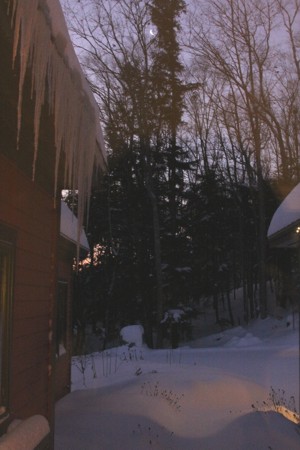Gutter Ice
Gutter ice is really common in areas that get a significant amount of snow. There are several factors that contribute to gutters and ice that accumulates in and above the metal channels.
Ice in gutters forms rapidly as the temperature hits 32 F and lower as metal conducts cold very well. Any water that is in the gutter is often at the same temperature as the air temperature, unless it's being heated via direct sunlight and is flowing across shingles warmed by the sun. The cold water in contact with the cold gutter metal flash freezes. Any water that then runs across this ice is chilled as well very rapidly.

Icicles forming on gutters. PHOTO CREDIT: Brent Walter
A gutter ice dam will start to form if the gutter is in the shade or its temperature is at or below 32 F as stated above. If additional super-chilled water flowing down the roof hits the ice forming in the gutter, it starts to build a layer of ice within the gutter. This can happen very rapidly, and the buildup of ice can grow an inch or more per hour just like ice cubes grow in an ice machine.
Gutter ice dams present a clear and present danger to houses. If the water continues to flow down the roof, the ice grows higher and higher above the gutter making a true dam structure. The water flowing down the roof can then back up and flow under the shingles into the house or through a soffit overhang. Low-pitch or slope roofs are more prone to interior damage than roofs that are steep. It takes a higher ice dam to get water to back up into a house that has a steep roof.
When gutter ice melt water contacts cold downspouts, it can freeze and clog these tubes. Once the downspout clogs with ice, the water from the roof has nowhere to go but over the top of the gutter. This often creates massive icicles that can rip the gutters from the house as the weight of the ice in the gutter as well as the icicles overwhelms the fasteners used to attach the gutter to the house.
You can prevent leaks from gutter ice melt by installing an ice-dam membrane under the shingles at the lower edge of the roof. These membranes will not allow the melt water to flow into the house. It's best to install these when a new roof is being installed. They can be installed on an existing house, but the first 4 feet of roofing material has to be stripped off the roof. The ice-dam membranes get attached directly to the wood sheathing that's nailed to the roof rafters or trusses.
 |
Hi, it's me Tim Carter. Do you want a bid on the same gutter guards I used on my home? Click Here If you do fill out the form at the MasterShield page, they pay me a very small commission. |
Column QA